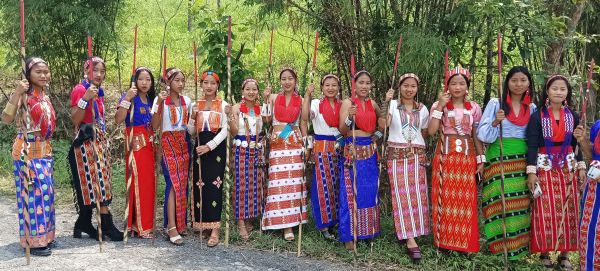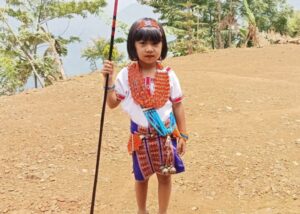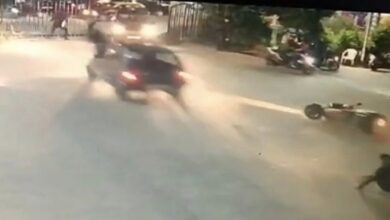A tribal festival for women, by women & of women
Wancho tribe of Arunachal Pradesh celebrate nature, womanhood & fertility through Tahthavan in different villages

 Tahthavan or Sahchavan is a Wancho festival (in Arunachal Pradesh) that is celebrated across the Longding district. Although it varies slightly from village to village by name and the mode of celebration, the basic theme of the festival is the same.
Tahthavan or Sahchavan is a Wancho festival (in Arunachal Pradesh) that is celebrated across the Longding district. Although it varies slightly from village to village by name and the mode of celebration, the basic theme of the festival is the same.
The name of this festival is a combination of two words — Tah refers to paddy, and Thavan, which suggests inviting the spirit. Thus, the literal understanding of Tahthavan is to invite the paddy spirit home.
The objective of the Thavan celebration is the wish for a plentiful harvest, especially millet, which is grown on the newly cultivated jhum land. It is also regarded as a women’s festival that symbolises new productivity. For this reason, the girls who have attained puberty are expected to become initiated during the Thavan festival through the ceremony of wearing loinclothes.
In the past, Thavan marked the day a girl starts to cover her body with a piece of cloth after a rite that is traditionally performed by an elder woman of the clan. The rituals are performed in the field hut, which is called Taap, and no men are permitted in the event. Women of all ages can take part in the girls’ initiation procedure on the main day of Thavan.
Men are accustomed to preparing and distributing meat during every festival event, but during this festival, the women make the arrangements for sharing meat equally with all the participants in the field. Besides meat and fish, fermented soybean, dry bamboo shoot, gourd, mushroom, walnut and green leafy vegetables are found on the festival menu.
The celebration

Before the Thavan festival, the domestic cattle (mithun and buffalo) are brought home. The festival starts with the capture of the domestic mithun (Bos frontalis). A day before the festival, pigs and smaller animals are sacrificed for meat.
The second day is the main celebration day, Sahphuak, which translates to collecting young millet grass from the field. These bundles are tied to the main pillar in the house (called Khamchong) after evening rituals, performed by the eldest woman in the family.
Each piece of millet grass would be tied to a living tree near the house with a wish for the healthy growth of other plants. This day is often called Thotat, which refers to the use of three small bamboo tubes for the rituals. One of the tubes is shaped with a sharp edge at the top.
The role of priests on Sahphuak

The presence of the priest during Thavan is mandatory. The priest is locally called Gampa. He has to collect the old flattened basket, called Tapa, which is usually hung in front of the house, from every household in the village in the morning. The Tapa must be attached with sparrow droppings and Tonpee, which is the leftover semi-liquid residue of wine production from rice, millet or tapioca.
These two ingredients must be wrapped in a banana leaf. The paddy husk, which is called Viak, must be burnt below the Tapa. The process of collecting Tapa from each house is called Kaajen-hai. The sparrow dropping is fixed to the basket because it is believed that once it has burnt to ash with the old baskets, no birds (particularly referring to sparrows) will consume the ripe millet before the farmer’s harvest.
Soon after, when all the women have gone to the millet field, the priest (Gampa) begins the rituals in the area called Paan-phang (located beyond the last house in the village by the footpath leading in the direction of the jhum fields).
Two Gampas are assigned to perform the rituals on the day of the Thavan festival. On arriving at the chosen location, the Gampa lights a flame and burns all the old baskets that have been collected from each household. He then makes a new type of bamboo basket called Kahtaap for keeping Tonpee. He also makes a hole so that some of the fluid that flows from Kahtaap is collected in a bamboo tube. The amount of juice is examined the following day: if the fluid collected measures up to about 4 inches, it is seen as a good sign for the entire year, especially for attaining a rich yield from the new jhum cultivation land.
Before burning the old baskets (Tapa), the priest chants a message: “Onu Juhnu daam, ala achak phai ngo, Otho juh thadaam o”, which means, “This symbol that is burning to ash represents the birds and the rodents, therefore let there be no harm to our seasonal crops”.
Significance of husk & sparrow droppings
The sparrow is the only bird not hunted by mankind in Kamhua Noknu. Together with rodents, it consumes the largest quantity of millets and paddy in the field. Sparrow dropping is used in the ritual to control the invasion of birds and preserve crops.
The burning of husk is also considered of special importance: if the smoke persists the day after the burning of husk, it is perceived to be a good omen.
The women’s role

Thavan is the only festival where women are honoured by men and they are free to enjoy themselves in the field. The men arrange sufficient meat and rice for their womenfolk. The ladies, dressed in their traditional attire, walk to the millet field. Each clan arranges its camp in a field hut (Taap). During the day, the elderly women initiate the ceremony of dressing the younger ladies, who have attained adulthood, with the white cloth. In the past, it was a formal procedure that entitled the girls to wear a cloth for the first time, and the use of cloth to cover the body would continue from that point.
The eldest woman in the clan would put the cloth on the body of the girl while chanting: “Chinih mann ey, aga jong cha thong pu o, lowang nau mai ya, jong pha, diak cha po mai pha”, which means, “This girl has become an adult now; let her blossom and have a successful life blessed with many strong offspring”.
Meanwhile, some of the middle-aged women would start distributing meat wrapped in banana leaves equally to all the participants in the festival. The meal includes various meat items that have been brought to the field hut from the respective households. Those are served age-wise from the most senior to the junior.
After lunch, the women pluck some young millet grass and return home. On the way back, they stop at places that are called Chanja (locations for resting on the way back home from the field). They sing folk songs, tell jokes and enjoy traditional sport and entertainment.
On reaching the village in the evening, the girls and some elder women led by the princess, visit six different places where a swing (Gulay) is made, and the ladies swing together with merriment.
Role of adolescent boys
The young boys called Dala (who haven’t attained adulthood) are expected to collect Bikok Gu (creepers that are used as the ropes for swings) early in the morning from the forest. Each morung (men’s dormitory) group ties the swing on the branches of big trees (preferably banyan trees).
Locally, the swing is called Gulay, and it is made to amuse the young girls. In the past, it was believed that the swing was made for the princess of the village: she would marry the king of another village one day and swinging during the Thavan festival would bring good memories of the time she had spent in her childhood home.
The boys sang romantic folk songs while the girls were on the swing. The teenage boys would sing and dance around the village, forming a human train. While singing, the boys would stand age-wise from senior to junior: moving together and zigzagging in synchronicity without breaking the row. It is said that they resembled centipedes.
When the main day of Thavan comes, the adolescent boys would start singing before the crow of the rooster at dawn. During the day, the boys would gather on the other side of the Chanja and engage in traditional sports such as high jump, wrestling and pushing out of the ring. In the evening, the boys would sing and dance in the same manner until night.
The boys from part one (Chingkhau) and part two (Chingkay) would meet at the Hau (banyan tree at the centre of the village), and the event would gain momentum. There would be competing songs from both sides.
In the past, the names of anyone perceived to be at fault, for example, a thief or a traitor, would be called out in the songs that recounted the offender’s misdeeds. This was intended to shame the culprit so that the others would be deterred from similar activities.
There was rivalry displayed in the dances and songs of Chingkau and Chingkay that reflected the celebrations of wars that had once taken place. The dance troops from both parties kept themselves mentally and physically alert, responding to each other through verbal expressions and challenges in the form of traditional songs.
Often, there used to be an exchange of hot words while singing. However, the chief used to come out in between Chingkhau and Chingkay dance troops, letting out from confronting face to face to ensure peace and avoid any kind of physical violence among the traditional dance troops.
Types of songs
It is the festival of young people, and the songs that are sung during the Thavan proclaim the bravery of ancestors and the victories over rivals and enemies. Such songs provoke young people to remember the tales of their forefathers and inspire them through songs such as Khansa-lau soan. These songs compare the alertness of human beings to the wild cat. The Mohum baat is another form of song sung in groups led by elder guides.
The attire worn by boys and girls
The adolescent boys wear a hat made of bamboo. The senior ones have a bamboo cap called Layphai kontam that are decorated with hornbill feathers, and the younger boys use a bamboo hat called Kholo-kontam. They tie tender palm leaves called Lohkhuak on their legs. The small boys hold a stick called Pahpho, which is elaborately decorated with rooster feathers.
The girls, who have completed the female initiation ceremony, wear a white cloth around the waist and bead necklaces of different colours. For distinct appearance, Queens can put on traditional headgears with more than one hornbill feather fixed, but common ladies should have one feather on their caps.
Food & taboo of the Thavan
Vegetable dishes, rice and meat are provided to the females to take with them to the field for the celebration. The leftover meat and rice are brought back home and are not given to the male members of the family. It was believed that eating the ladies’ leftover food would negatively affect the hunting and fishing expeditions, and it was, therefore, to be strictly avoided.
The story of mithun
It was believed that all living creatures could communicate with each other. One day, a cereal crop (it may have been paddy) was asked: “How will you escape the ferocious tempest that comes your way?” The cereal crop replied, “I shall hide behind the rocks and the tree trunk”.
A second question was asked of the crop: “Where will you go if there are neither rocks nor wood?”
The reply came, “I shall move to the place where cattle reside”.
This short fable has inspired man to think that mithun and buffalo need to be brought home during the Thavan festival, which is intended to evoke the rites and rituals that invite the spirit of the cereal crop. The festival brings an excellent harvest and increases the productivity of domestic animals and the crops that are planted in the jhum cultivation land.
In the evening, when all the ladies are sure to have returned home from the field celebration, the senior male head of the family performs the rituals of a live rooster (or an egg if a rooster is not available). The rooster is sacrificed and cooked for the family. The rituals for cattle are performed to seek divine blessings and the prosperity of increased cattle in the following year.
Duration of the Thavan celebration
In the past, Thavan was celebrated for three days. The first day was called Thotat/Saphuak, which was the main festival day. The second day was Thoknu, which was the first day of enjoying the swing. The third day was called Thoksa, or the second day of the swing.
The same format is followed even today.
After all the rituals on Day 1, the second day is for entertainment by the teenage boys. On the day of Thoknu, the captured mithun are released in the jungle early in the morning. The boys make merry the entire day performing traditional folk songs and dances in the place called Panphang-Chanja (resting places on the outskirts of the village). The same programme would be followed on the Thoksa day too.
Tug of war
After the field celebrations and as a part of the Thavan festival, a tug of war event takes place between girls and boys late in the evening after dinner. The boys call their friends through songs and invite them to take part in the tug of war. The girls do the same.
An equal number of girls and boys gather for the tug of war challenge. The wild creeper, or Bikok Gu, is used as the rope.
Tahthavan, which is termed Sahchavan in the lower Wancho area, is a summer festival. The form of its celebration may vary from village to village, but the essence of the celebration is the same. In the past, the Wancho people worshipped nature, and they believed in spirits that reside in every living creature. So, they wanted to pay respect to the crop and animal spirits so that they would not suffer drought and famine.
Our people wanted to make the omnipotent and omnipresent God happy by reinvoking nature worship. The Thavan festival is, therefore, an appeal to the Nature God for prosperity and fertility through the female initiation ceremony. In the upper Wancho area, in the short form, it is also called Thavan or Thagan.





